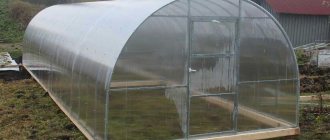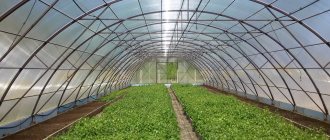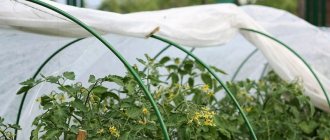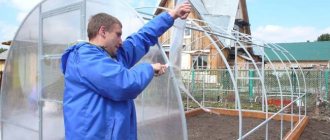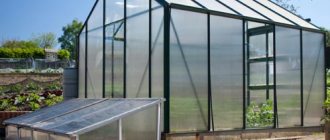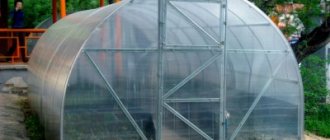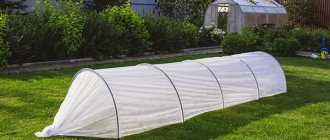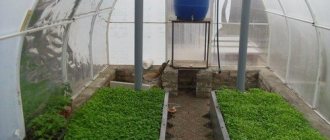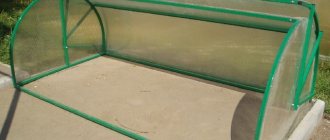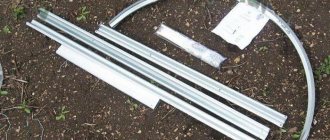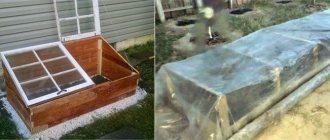The high dependence of garden crops on weather conditions creates problems when growing them in open ground. The main threats to outdoor plants are the following:
- frosts on the ground and in the air;
- unpredictable growing season;
- lack or excess of moisture;
- damage from insects and so on.
A greenhouse or greenhouse will help solve these problems. Growing garden crops indoors guarantees high yields compared to conventional farming methods. Here we will try to answer the question of how a greenhouse differs from a greenhouse from a practical point of view.
Greenhouse: design features, pros and cons
The predecessors of greenhouses were used in ancient Rome, and with the advent of translucent materials for shelter, these devices acquired an almost modern appearance. By their essence, greenhouses are covering beds. Their distinctive features are as follows:
- relatively small size, including height, so greenhouses are primarily used for growing seedlings and low-growing plants;
- the use of natural heat sources for heating - sunlight and energy from the decomposition of plant waste (compost), bird droppings and herbivorous animal manure;
- absence of signs of capital construction - foundation, windows, doors;
- simplicity and minimalism of the design, allowing quick installation and dismantling of the greenhouse;
- seasonality of use, which is usually limited to periods of risk of late and early frosts;
- Plant care is carried out without a person entering the greenhouse.
It is possible to complicate the design of a greenhouse (for example, equip it with a heating system), but it is not advisable. In this case, it is better to build a greenhouse. However, the difference between a greenhouse and a greenhouse is too significant, including in terms of material and financial costs.
Setting up a simple greenhouse will not take much of your time. To do this, the following work must be completed in the fall:
- choose a suitable place - it should be well lit, not shaded and not located in a low area;
- remove soil along the contour of the future bed or make parallel grooves 30–40 cm deep;
- fill the excavations with compost and/or partially rotted manure, and then cover them with loose soil; the height of the resulting bed above the ground level should be 20–30 cm;
- install a frame over the bed from scrap materials or purchased ones;
- Closer to spring, cover the frame with film or other translucent material, but provide for the possibility of opening it to ventilate the greenhouse.
You can start planting in a greenhouse after the snow melts. Before this, you need to keep it under the film for 3-4 days, during which the soil will have time to warm up enough for sowing seeds or planting early seedlings.
The advantages of using greenhouses for growing garden crops are as follows:
- they extend the favorable growing season by 1.5–2 months;
- allow you to obtain strong, hardened seedlings with high survival rates;
- constructing a greenhouse is an order of magnitude cheaper than building greenhouses;
- a greenhouse can be made almost anywhere.
If you intend to grow vegetables only for personal consumption, use the advantageous differences between a greenhouse and a greenhouse to your advantage.
Greenhouse: design features, pros and cons
Greenhouses with heating systems also have a long history, dating back to ancient times. They were forgotten for a long period, and interest in them was revived with the advent of fashion for growing exotic plants and fruits. Greenhouses were transformed into greenhouses and winter gardens, which were incredibly expensive to maintain and available only to very rich people.
A greenhouse is also called a heated greenhouse, although this definition is not entirely correct due to significant differences between these types of buildings. The main difference between a greenhouse and a greenhouse is as follows:
- greenhouses are exclusively stationary structures;
- they contain all the signs of permanent buildings;
- greenhouses allow you to regulate the indoor microclimate and apply any technology for growing plants through the full biological cycle;
- greenhouses must have a heating system and artificial lighting, which ensures year-round harvesting;
- All plant care work is done inside.
The construction of a greenhouse is greatly simplified by the large number of offers of factory-ready greenhouse kits. All you have to do is make a foundation on which the greenhouse will be mounted, and supply light and water to it.
Greenhouses can take up huge areas. This is another answer to the question, what is the difference between a greenhouse and a greenhouse. This cannot be done without a heating system. Other differences between a greenhouse and a greenhouse lie in the possibility of equipping them with additional equipment for growing plants hydroponically, lighting with selective use of ranges of the solar spectrum. In a greenhouse, all this is simply impossible.
Accordingly, the cost of building and maintaining greenhouses is orders of magnitude higher than similar indicators for greenhouses. However, the increased costs are fully compensated by the high productivity of greenhouses, including taking into account their service life, which is designed for many years and even decades.
The advantages of greenhouse farming are obvious. In relation to growing vegetable crops in greenhouses, these are:
- creating optimal conditions for plants at all stages of their development - sowing, germination, growth, fruiting;
- the ability to grow any vegetable crops, including exotic ones;
- maximum productivity of plantings per 1 m2 of area;
- the ability to organize optimal crop rotation on relatively small areas with the correct alternation of predecessors;
- rational use of fertilizers and plant protection products;
- minimal losses from pests and crop diseases.
Thanks to all of the above, greenhouses are the best way to grow vegetable (and other) crops in commercial quantities. This is available to both individuals and large agricultural producers.
Agrofabric Kron
It is used as a flooring between cultural plantings. Most often used for mulching against weeds.
Agrofabric from the Kron company is presented in black, since black color is least susceptible to the penetration of ultraviolet rays.
Main functions and properties of agrofabric:
- Protects against weed formation
- Permeates air, water and mineral fertilizers
- Allows you to reduce the number of waterings
- Retains moisture in the soil
- Protects the root system of plants from overheating or hypothermia
- Increases soil fertility while retaining essential minerals
- Protects fruits from rotting
- Protects from pests
- Protects against frost
- Durable, minimum 4 years of service
______________________________________________________________________________
Use the Promo Code “NO WEEDS” and receive an additional 10% discount on your order!
Photo: order agrofabric for fabric on the website krongarden.ru or by phone. +7 (495) 504-66-83
Ready-made greenhouses
Currently, in stores you can purchase ready-made greenhouse designs with convenient fastenings and clamps for covering materials. Their price is quite affordable.
- Special arcs of various lengths and pointed tips fit perfectly into even the hardest soil and hold the covering material even in strong winds using special plastic clips.
- Given their convenience and ease of use, ready-made greenhouses can be used for more than one season.
I myself have repeatedly used ready-made greenhouse shelters. This significantly accelerated the emergence of seedlings and shortened the harvest time. _______________________________________________
SLIDING GREENHOUSE FOR YOUR BED WITH YOUR HANDS
Photo: finished greenhouse - nursery
Greenhouses for home use
Greenhouses can be installed both outdoors and indoors, even on a balcony or loggia.
- Now compact mini-greenhouses or grow tents (grow boxes) have appeared.
- Their dimensions can be no more than 50x50 cm.
At home, seedlings, herbs, small shrubs or berries are most often grown.
Photo: home greenhouse - growbox
Simple DIY greenhouse
I’ll tell you how to make a greenhouse with your own hands using the example of a frequently encountered classic greenhouse.
Greenhouse on manure
- A layer of manure, preferably horse manure, is placed in a dug trench about 0.5 m deep. It provides the most heat.
- After the manure settles, a layer of soil is poured on top. This will become the basis for the growth of our cultures.
Heating occurs due to self-heating of the manure layer.
- If there is a problem with manure, the greenhouse box can be installed directly on fertile humus soil without digging a trench. Heating in this case will only be solar.
- Manure is prepared in advance, because It’s not worth putting in a burnt-out one, it won’t be of much use.
When there is no longer a need for a greenhouse, the used manure can be used as fertilizer for the beds.
Photo: covering a greenhouse with non-fabric
Greenhouse frame and cover
To install a greenhouse, it is advisable to choose a drier area that is well accessible to light and protected from harsh winds.
- When constructing the frame, the north side should be made 10-12 cm higher than the south side for uniform illumination of the plants.
- The covering material must fit tightly on all sides to avoid heat loss.
In the future, it is necessary to monitor the microclimate inside the greenhouse, ventilate and shade it if necessary. ______________________________________________
GREENHOUSE ON A HIGH BED WITH YOUR HANDS
Photo: we used such a greenhouse at our Far Eastern Research Institute of Agriculture
Greenhouse: frame, shelter, dimensions and purpose
— A greenhouse, unlike a greenhouse, is a multifunctional, stationary, large structure (from 2 m and above) both in height and width.
— Another significant difference between a greenhouse and a greenhouse is the much higher material costs for a full range of equipment and maintenance.
- The greenhouse is installed on a foundation made of any suitable material: wood, cement, blocks.
- The greenhouse must have doors, windows or vents for caring for plantings and ventilation.
- The basis of greenhouses is a frame: arched, horizontal, gable, wall.
Our experience has shown that arched greenhouses are the most convenient:
|
____________________________________________
HOW TO PROTECT A GREENHOUSE FROM THE HEAVY OF SNOW
Photo: arched greenhouse - the most convenient for harsh climates
Greenhouse frame
Frames are made of metal (galvanized steel), plastic or wood.
- The metal frame is more durable, stable and durable.
- The plastic must be very durable with an internal pipe diameter of more than 2 cm.
- Wood is very often used by summer residents due to its low cost, availability and environmental friendliness. However, the tree is very short-lived (lasts 5-10 years) and can quickly rot due to improper care.
Photo: greenhouse on a wooden frame
Dimensions and purpose of the greenhouse
The areas of greenhouses vary depending on the area of activity, the possibility of care and the need for crop volume.
- Small greenhouses, up to 15 m², will be needed to satisfy the vegetable needs of a small family.
- You can place quite large volumes of not only seedlings in one greenhouse, but also get a full harvest of any crops, even quite large and tall ones: tomatoes, corn, watermelon, cabbage.
- Often, not one, but several types of plants are grown in a greenhouse, taking into account their compatibility.
- The main soil area is occupied by the most important crops.
- For more optimal use of protected soil, greenery, small root crops, vegetable and flower seedlings are planted along all sides of the greenhouse.
Large volumes of protected soil are necessary for the industrial production of seedlings, vegetable products and flowers.
_______________________________________________________________________________
| Tomato Everyone's envy F1 |
Innovative hybrid F1 is the envy of everyone, obtained in the classical way, without the use of GMOs.
- Early ripening, indeterminate, for closed ground.
- The bushes are sparsely leafed, compact and grow in height rather than in width.
- It is worth forming into 3-4 stems.
- The cluster is simple, consisting of 7-10 fruits.
Photo: productive tomato hybrid Everyone's envy for greenhouses
The fruits have an excellent ratio of sugars and acids, which gives them a special, unusual, fruity taste and aroma.
- The fruits are round, glossy, weighing 60-80 g.
- As they mature, they acquire a rich blue-black-violet color.
- The pulp is dense, cherry-red in color.
The hybrid has excellent decorative properties - a wonderful and unique decoration for your garden.
Photo: tomato fruits Everyone's envy
Similarities and differences between a greenhouse and a greenhouse
The similarities and differences between a greenhouse and a greenhouse are determined by their purpose. Among the related factors:
- the possibility of using the same types of structural materials for construction - metal frames, translucent polycarbonate, etc.;
- the same principle of structure layout;
- creating comfortable conditions for growing plants;
- mandatory ventilation of the internal space;
- primarily used for growing garden crops.
However, there are many more differences between greenhouses and greenhouses. First of all, they relate to the following aspects:
- a greenhouse is a seasonal structure, and a greenhouse is designed for year-round operation;
- the greenhouse has all the signs of a capital construction, including a foundation, doors, heating system, ventilation, artificial lighting, but greenhouses have none of this;
- the greenhouse is many times larger in size;
- To organize plant care work, you don’t need to go into the greenhouse, but in a greenhouse everything is done indoors.
Perhaps we are repeating ourselves in some ways, but this serves as further confirmation of how different greenhouses and greenhouses are from each other.
How to make a roof?
The roof of the greenhouse can also be made either single or gable. The lean-to option is suitable for narrow buildings, 3 to 5 meters wide. But for wider buildings, so to speak professional ones, it would be better to make a gable roof. It is recommended to make the central ridge as close to the center of the greenhouse as possible and raise it relative to the side walls to a height sufficient for more or less unhindered precipitation, which is most typical for your region. But do not forget that if you start work at the end of winter or early spring, it is possible that you will have to manually clear the snow from the roof and around the greenhouse.
Next, stretch the film. The polyethylene film that must be chosen to cover greenhouses must be of sufficient thickness. Thickness is measured in microns. The optimal thickness is 120-150 microns. A film with a thinner thickness may not withstand wind and friction against a wooden frame. For example, a film with a thickness of 80 microns breaks in your hands even while stretching. And you need to pull it as tight as possible.
Important! The fewer folds are allowed when installing the film, the less often you will have to pour out rainwater from the accumulated mini-lakes. Also, do not forget the fact that the film stretches over time. It can be attached to a wooden frame using wooden slats with nails; you can use plastic rope from a hardware store for this and tape the film to the frame. This method is also advantageous in that there are no extra holes from nails in the film.
Which is better - a greenhouse or a greenhouse?
The answer to the question, what is the advantage of greenhouses over a greenhouse, should take into account the tasks that you set for yourself. If you are only interested in meeting your personal and family needs for vegetables, then you should not build a greenhouse. It costs too much for this.
For growing vegetables in commercial quantities, a greenhouse is definitely better than a greenhouse. On the other hand, one should not raise the question of what is better - a greenhouse or a greenhouse, with a hint of their opposition. Both types of structures coexist perfectly and complement each other.
For example, you should not take up valuable greenhouse space by growing cabbage or onion seedlings. A greenhouse can cope with this task much more effectively. Finally, compared to a greenhouse, a greenhouse costs practically nothing, and this is also an important argument in favor of simpler solutions.
